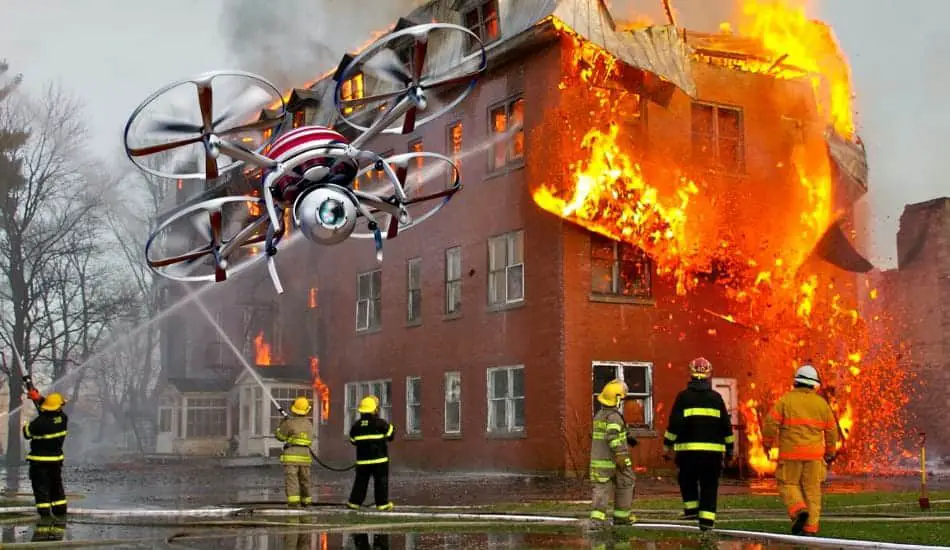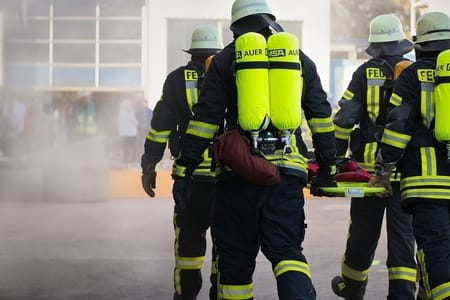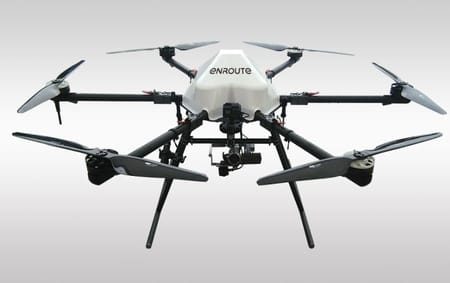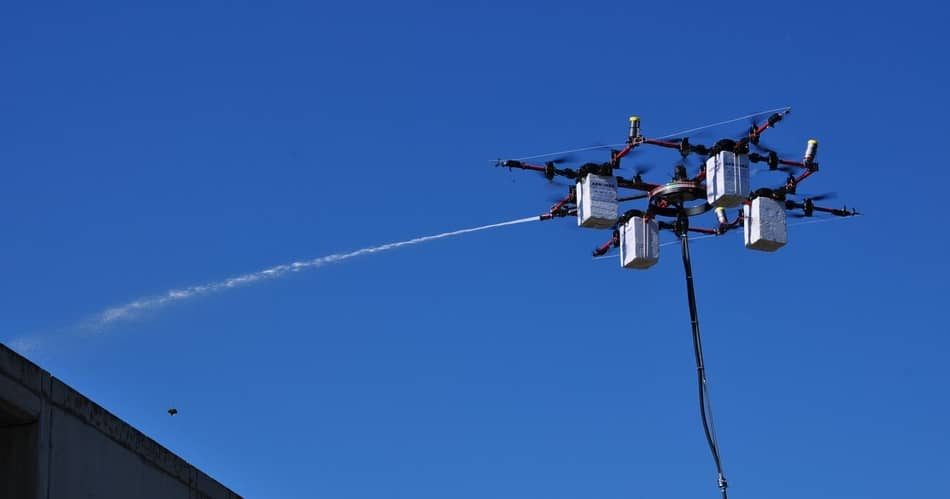Firefighting Drones: How Drones Help Fire Departments

Drones can already deliver more than just snapshots from the air: thanks to 5G and high-resolution cameras, they are also used by rescue workers and firefighters. More and more fire departments decide to buy a flying drone.
There are many possibilities for their use: from the exploration of the location and the search for persons to the measurement of hazardous substances, the range of applications of the drones in the fire department extends. We explain you the different application possibilities as well as the legal bases.
The big advantage is that drones can get into areas that are too dangerous or unreachable for humans. Bird’s-eye-view images provide task forces with an overall view of a deployment site. In addition, UAS are a cost-effective alternative to helicopters and surveillance aircraft. And the reach of aerial ambulances is limited.
Rules And Responsibility in Firefighting Missions
Before procuring a firefigthing drone system, the following questions should be resolved:
- Who is the responsible person in action? According to the ascent permission, the pilot in charge and ultimately also the responsible task leader are responsible.
- Who bears the costs of resulting damage? Insurance protection for fire brigades and aid organizations for economic damage exists through the local authorities as the policyholder. These must comply with all regulatory requirements and ancillary provisions.
- Who decides whether an accident happened due to technical failure or improper use? So far, the Federal Agency for Aircraft Accident Investigation (BFU) in Braunschweig is responsible. But the insurers will also turn to a given interest.
- What happens when people have been injured? Surely the health insurance companies will first bear the cost of care for injured emergency personnel and uninvolved persons. However, if it comes to more serious injuries or more expensive treatments, the health insurance may demand regress.
How Firefighters Today Use Drones in a Major Fire?
An example of a fire occurred in an enclosed hall. Firefighters and a couple of special drones participated in the firefighting. “Until then, it was not known what would happen after the fire inside the hall. A view from above of the object did not help much. “So a hall wall was opened so that the drone could fly inside. So the forces directed the aircraft between two steel girders into the building. “We discovered a smoke development in the middle of the hall,” says the city fire inspector.
The fire department suspected there a dangerous chemical reaction. But the even greater danger represented the possibly unstable roof construction of the hall. Finally, a structural engineer examined the condition of the steel girders on the basis of the Copter photographs. He decided that forces could move up to smoke.
Also in the orientation of the troops in chemical protective suits the drone was helpful. That was a highly critical mission, but the drone was very helpful.
The fire department has now equipped their drone with a thermal imaging camera (WBK) to expand the range of applications – for example, in the search for people. Although this is the task of the police, it often happens that the fire brigade is requested to assist. Often forest areas have to be searched for people.
Firefighting Drones And Their Future Use
The drone’s mobility is best suited to disasters, firefighting, and rescue operations, where accurate understanding of the site conditions and initial response are the most important issues. In the 2016 Kumamoto earthquake and the July 2017 heavy rain in northern Kyushu, drones were introduced to check the status of disaster sites and damage. It ’s been a great achievement.
The drone has the advantages of being able to be introduced on a low budget, being able to be operated by trained personnel, and being compact and easy to store and move. The deployment of drones to firefighting and municipalities is expected to greatly increase the mobility of disaster prevention and rescue activities, and achieve great results in disaster rescue activities. Check also 10 Ways Drones Will Be Used in The Future
Expected use fields of drones for fire fighting and disaster relief:
- Checking the status of the fire site
- Checking the status of forest fires
- Search for rescuers
- Understanding of surrounding information such as traffic accidents
- Transporting and dropping emergency materials
- Dropping rescue materials
- Investigation of large-scale wide-area disasters

Drone Performance That Are Required For Firefighting
In order to utilize drones in natural disasters and fire scenes, it is a prerequisite that they can be used safely. To that end, in addition to reliable maneuverability, safety devices that can respond to emergencies such as a loss of communication or running out of battery are required.
In addition, in fields that can only be approached from the sky, autonomous flight capability that allows non-visual flight, waterproof performance that can be launched even with some rain, and flight performance that can withstand gusts and updrafts are also important.
In order to check the situation of the site, a video transmission function that can shoot and transmit the site and a loading capacity and winch that can carry relief supplies and lifesaving materials at the lifesaving site are also required.
The Various customizations are possible, including transportation and air transportation. Equipped with a high-sensitivity camera and infrared camera that accurately conveys the situation It is the most important issue in the event of a disaster to quickly catch the situation at the site and establish an accurate initial action system.
Enroute’s fire-fighting and disaster prevention drone can be equipped with a camera suitable for the application, such as a zoom-type high-sensitivity camera that is useful for search activities, and an infrared camera that can check the situation even during smoke screens or at night.
How Quick Drone Response is Crucial to the Rescue
The drone’s mobility can be reached in a short time, even on-site that is not easily accessible. Enroute’s fire and disaster prevention drone can be equipped with a high-performance winch instead of a camera unit. Up to 5kg of rescue and lifesaving materials, such as AEDs and lifebuoys can be mounted and safely dropped on the rescuer with a winch. We support rescue and lifesaving activities. Ensuring flight capability during rainfall

Disasters occur day and night. In particular, the weather after a natural disaster is not stable, and the drone’s dispatch is in danger. Enroute’s fire-fighting and disaster prevention drone has a waterproof performance equivalent to “IP standard 2 grade” so that it can be deployed even during rain (airframe body).
In addition, stable flight up to a wind speed of 10m/s is secured, reducing drone dispatch loss due to weather. Introduced en-route fire-fighting rescue drone at the Kanazawa City Fire Department The flight performance is about 15 minutes of cruising in the wind speed of 10m / s, and the waterproof performance is equivalent to IP standard 2 grade, and it can be dispatched in a little bad weather.
The Best Firefighting Drones in LA Fire Department
The Los Angeles Fire Department (LAFD), which aims to modernize its fire fighting activities, is considering the introduction of a number of the latest technologies, including expanding the drone fleet and expanding it on a large scale. LAFD already has a fleet of eleven drones, complementing the fleet of 258 fire trucks, ambulances and helicopters.
Los Angeles helped with an agreement with Chinese drone maker DJI, pioneered drone use for firefighting activities, but signed a contract with the company in April. At that time, Chinese company DJI, which develops the drone and develops image processing technology, announced that it would test and deploy the drone as a tool for emergency response preparation.
The company says it will be the largest contract with the US fire department. One of the most famous models is the DJI Phantom 4 Pro (Check price, reviews and pics).
“I am very happy to be able to use the advanced technology of DJI drone technology developed exclusively for the Fire Department by strengthening our alliance with LAFD, an outstanding security agency in the United States”
Partnership manager Bill Chen said in a statement at the time of the contract. Fields says the technology demanded by the fire department doesn’t stop at the drone itself. “To increase the versatility of drones, a lot of technology is needed. [Omission] The most valuable tool is not a drone but its sensor.” The most effective use to date has been to balance the visible features of infrared technology with the thermal characteristics detected by the sensor.
The Use Of Firefighting Drones in The World
Drones are still an exception in firefighting in the district of Friesland. Zetel showed how practical they are for the fire brigades. Firefighting drones are handy: They come almost everywhere, provide aerial photographs and are relatively cheap.
That makes them interesting for the work of the fire brigades. In Zetel, it was only recently that the source of the fire could be identified. Residents and firefighters could smell the fire, but could not find it. But the fire was hidden too deep in the forest. Only the use of a drone led the comrades within minutes to the fire.
The device used, however, was the private drone of a firefighter. Own drones do not have the fire brigades in the district Friesland yet. But: The weirs are already on the topic. According to Stefan Eilers, community steward in Zetel, the topic should also be addressed in the next community firebrand round.
Related Article: Best Drones For Emergency Services
Special Rights and Laws for Fire Fighting Drones

The Federal Council has approved two crucial points for the fire service and other rescue services for the drone regulation of the Federal Government. Fire brigades are exempted from the duty of proof in operational situations.
And very important: over-flying of deployment sites by third parties is prohibited. “Fire brigades are exempt from the obligation to provide evidence in accordance with Paragraph 21a (4),”. The Regulation reads as follows: “No permit […] and no proof […] shall be required to operate unmanned aerial systems, through or under the supervision of safety-related organizations in response to emergencies, disasters and disasters.”
This is explained that fire brigades, as organizations with safety responsibilities, are expressly exempted from the duty to operate unmanned aerial vehicles, when used in connection with emergencies, disasters and disasters.
Also preventive missions, for example for the situation survey, at large events belong to it. Included here is the operation for training and practice purposes. The regulation also covers the operation “under supervision”. “This records the cases where the agency does not have its own equipment but has it made available.
In these cases, it oversees the mission and bears the responsibility, “it says in a statement. Another point: drones should not be operated out of sight – with a weight of 5 kilograms and less. “Here, too, there is an exemption for fire brigades,” says Oschmann. “Thus, drones can also be used, for example, to explore behind a smoke column or in smoke-filled areas, where otherwise a situation survey would not be possible or only with considerably greater effort.”
How Firefighters Are Trained To Use Drones And What Is Important
“Training is very important,” says Markus Hedemann in a nutshell. The professional fire fighter from Oldenburg leads as a platoon leader and responsible instructor the drone group of the district Cloppenburg (NI).
There is still no nationwide training standard. There are three ways to get a certificate – proof of practice that you can fly drones – to get a promotion permit. First, the “pilot” can get a safety briefing from the copter manufacturer, including a certificate. Secondly, model flying clubs are allowed to inspect and certify people to their practical abilities.
Thirdly, the responsible aviation officer can personally verify the pilot’s ability and issue a certificate. Thereafter, the permit can be applied for. A nationwide uniform training or a pilot course does not yet exist. One option is paid training.

